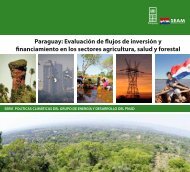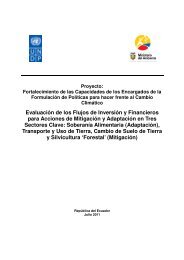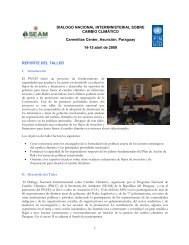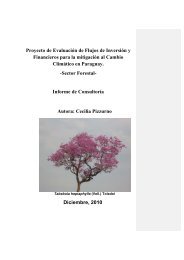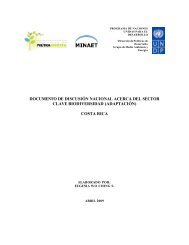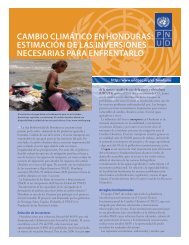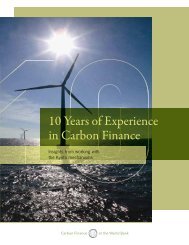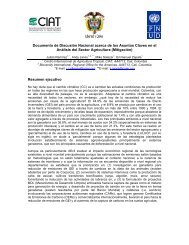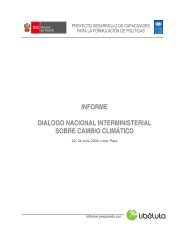VieTnam: why redd+ needs local people - UNDPCC.org
VieTnam: why redd+ needs local people - UNDPCC.org
VieTnam: why redd+ needs local people - UNDPCC.org
Create successful ePaper yourself
Turn your PDF publications into a flip-book with our unique Google optimized e-Paper software.
Great potential for active contributionAs most forest areas allocated to <strong>local</strong> <strong>people</strong> are relatively poor in quality, they have greater potentialfor rapid carbon stock increases than do better-quality forests such as those predominant in protectedareas. As REDD+ includes the enhancement of forest carbon stocks, reforestation and forest restoration bycommunities will make a significant contribution to the removal of greenhouse gases.Community monitoring can be a cost-effective alternative (and supplement) tointensive forest inventories conducted by external experts. Experience fromcommunity-managed forests in Nepal and India shows that with basic training,<strong>local</strong> <strong>people</strong> can assess changes in carbon stocks in their forests. 1 The resultsof such accounting can be reported to state agencies responsible for furthercalculations at higher levels (e.g. district or provincial). In a national REDD+program, where ground measurements of forest biomass must be carried out ona regular basis across the country, monitoring by <strong>local</strong> <strong>people</strong> provides an efficientand relatively inexpensive way of collecting data.Although many communities have rights to manage forestland, community forestryis not yet formalized on a large scale. The ‘package’ of procedures and institutionsrequired for this has already been designed. It includes village forest regulations,benefit-sharing procedures, community-based law enforcement, and communityforest management and protection funds. Several projects have successfullydemonstrated that collaboration between state agencies and <strong>local</strong> <strong>people</strong>, a keytenet of community forestry, can improve forest management. Experience alsoshows that <strong>local</strong> forest resources are often better protected and managed bycommunities than by State Forest Companies 2 or protected area managementboards, despite considerable subsidies and support from the State to the latter.Quality of forest allocated to communitiesunder CFM Pilot ProjectArea (ha)PercentBare land 2,383 14.1%Poor forest 10,411 61.7%Medium forest 1,735 10.3%Rich forest 242 1.4%Mixedtimber-bamboo2,004 11.9%Plantation 88 0.5%Total 16,863 100%Source: adapted from Community ForestryPilot ProgramGoing beyond social safeguards – adding value to REDD+ in VietnamAlthough social and environmental safeguards for REDD+ are not yet finalized, they were a key elementof the Copenhagen negotiations. For the Government of Vietnam to receive REDD+ finance from theinternational community, <strong>local</strong> <strong>people</strong> must be involved at every stage of planning and implementation.Their direct and transparent involvement is essential to build trust and confidence, and thus is an essentialprerequisite for REDD+ to succeed.In addition to delivering forest data and results, <strong>local</strong> <strong>people</strong>’s engagement in REDD+ also offers an opportunityto help address pressing social issues. Income from REDD+ could make an important contribution to povertyreduction among forest-dependent <strong>people</strong>. Data from Nepal indicates that at a carbon price of $US5 pertonne, revenue from forest carbon for <strong>local</strong> <strong>people</strong> may comprise some 30% of the net financial benefits fromthe forests they manage. 3 During the past fifteen years, Vietnam has made significant progress in reducingpoverty nationally, but much less in tackling rural poverty. The financial benefits from REDD may providemuch-needed supplementary income to rural <strong>people</strong> whilst enabling them to manage, and live in harmonywith, their forests.Globally, the mechanism for delivering financial benefits to <strong>local</strong> <strong>people</strong> remains to be developed. However,the Government of Vietnam is one of the first to take concrete steps towards developing an equitable andcost-effective benefit distribution system. 4Importantly, complementary payments to <strong>local</strong> <strong>people</strong> will be needed before performance-based paymentsare received at the national level. They would therefore be an important element of readiness activitiesfunded under UN-REDD and other mechanisms. These payments should be independent of the revenuegenerated by the achievement of future REDD+ targets, and instead focus on directly paying <strong>local</strong> <strong>people</strong>for monitoring work and other tangible activities that contribute to REDD+ readiness.1Reducing Carbon Emissions through Community-managed Forests in the Himalayas, Banskota K, B.S, Karky and M. Skutsch, ICIMOD 20072For example, see The Local Outcomes of Forest Devolution: Evidence from Dak Lak, Tran, T. N., Nguyen, T. Q., and Sikor. T. August 20033The Cost of Carbon Abatement Through Community Forest Management in Nepal Himalaya, B. Karky and M. Skutsch, March 20094Design of a REDD Compliant Benefit Distribution System for Vietnam, UNREDD Program, January 2010




